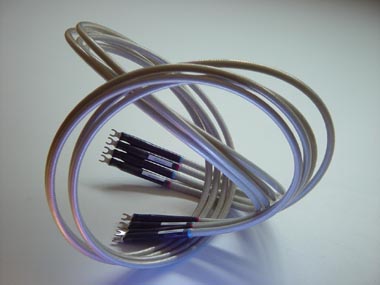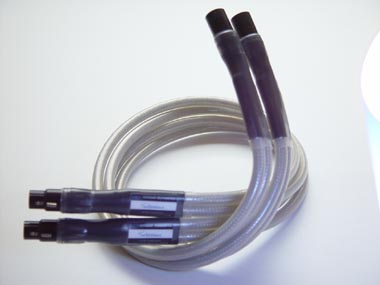You are reading the older HTML site
Positive Feedback ISSUE
19
may/june 2005
virtual dynamics
Testament Series of cables
as reviewed by John Beavers

|
JOHN BEAVER'S SYSTEM
LOUDSPEAKERS
ELECTRONICS
SOURCES
CABLES
ACCESSORIES
|
The Testament Series, the entry-level cable line by Virtual Dynamics, includes the "Speed of Light" and "Dynamic Filtering" technologies found in their Master series cables. The "Speed of Light" technology was created to deal with the magnetic fields formed by the circuits within audio components, which interfere with the flow of energy through the conductive pathways. To solve this problem, Virtual Dynamics uses magnets to create a stronger magnetic field than the ones generated within the circuits. "Dynamic Filtering" displaces vibration-born distortion within the cables by utilizing specially designed particles. The conductors are solid-core copper, chosen because of its ability to eliminate linear distortion. The cables have seven layers of dielectric that reject outside interference. They also have something called "True Float Ground Technology," which controls electromagnetic fields and protects against RFI with a specially designed metallic shield.
The cables are thick, and required some effort to install. The power cords, which have three separate runs of cable between the terminations, are the most bulky. Prior to hookup, they must be bent into the appropriate shape to reach between the wall outlet and the component. The fact that they hold the shape into which you bend them makes up for their stiffness and bulkiness. If you want to know what it's like to fight with a good-sized snake, try connecting a Testament speaker cable through a rack that has metal support rods! Keep a grip on the magnetic end of the cable, preventing it from wandering into areas of the cable and rack jungle to which you don't want it attached. The interconnects, though stiff, are easy to bend into shape. While they also have magnets near their terminations, they are less difficult to work with, as the path from one component to another is not as congested with magnetically-attractive temptations.
Once the installation was complete, I was ready to hear what my efforts at snake charming had accomplished. Some cables are decent right out of the box, others take a week or so, and some you have to be really patient with. The Testament cables require patience. They didn't sound bad at first, but I didn't hear anything special coming from my system. Things seemed a tad compressed, with some roll-off in the upper frequencies. The cables had a very full midrange. The bass was solid, but didn't have the impact or tautness that I was used to with my reference cables. The soundstage was fairly shallow, with not much imaging outside the speakers. These characteristics improved somewhat as time went on, but after about 100 hours, I began to wonder if I had heard as much as the Testament cables were capable of giving.
After the Testament cables had had around 150 hours of play, I went back to my reference cables and was again impressed by their more expressive character. After that, I procrastinated for about a month before returning to the Testaments. When the time came to finish my evaluation of these cables, I let them burn in for another 24 hours before getting back to serious listening. The first night I returned to the Testaments, I lost all of the progress I'd made in the break-in period. They again sounded compressed, with very little upper-frequency definition or weight. The sound was all midrange. This had the effect of making some voices and instruments sound big and full, but sounds in the rest of the frequency spectrum were tiny and faded within the sonic picture. It seemed that the cables had reverted to square one during the weeks in which they had not been getting signal.

Then, a week later, a sudden and dramatic transformation occurred. The sound balanced out. The highs, which had been very thin, took on serious weight and presence. The shimmer and sparkle that had been lacking in the upper frequencies filled in nicely. Transparency and openness emerged. What had been a very two-dimensional and closed-in soundstage now extended beyond my speakers, with full front-to-back imaging. The sound was now very full and rich. I heard more of the subtle sonic aspects of my recordings. I felt that I was being taken deeper into the music. I could easily detect fine sonic textures—the squeak of fingers sliding across the polished wood of an acoustic guitar, the action of a hammer hitting a string on the piano, along with the subtle reverberations of the wood cabinet. Horns took on a breathy tonality. The pluck of an acoustic guitar string reverberated in the air. I had made one of those transitions from hi-fi sound to true audiophile sound that we all seek, and pay so much cash for.
Speaking of cash, you're probably wondering what these cables are going to set you back. Here's where I give this product a major thumbs-up. Considering the price of the Virtual Dynamics Master series cables, I was expecting quite a pinch, but these are among the most affordable of high-performance cables. The 5-foot Testament power cords are $299, the 1-meter interconnects are $300, and the 12-foot speaker cables are $600.
As the ensuing weeks went by, I found myself discovering new aspects of familiar recordings. I've had a number of very fine cables in my system, including my current reference cables. Each brings its own special character to the sound. The Testament cables have their own signature in my rig, which I can put into one word—authority. These cables have a fully open sound, with some of the most impressive impact and transient speed I've yet encountered. I look for tonal neutrality and balance in cables, and the Testaments have succeeded in producing them in my rig.
How do the Virtual Dynamics Testament cables stack up to my reference cables? How does a good steak stack up to a tender filet of salmon? My reference cables are the most open-sounding cables I've heard, with air and separation to die for, but the Testaments are no slouches in this area. It's all a matter of which taste you prefer. I'd love to have both sets of cable, so I could just switch them weekly, varying my diet for good sonic health. The Testament cables by Virtual Dynamics are winners, and I heartily recommend them. John Beavers
Virtual Dynamics
web address: http://virtualdynamics.ca
